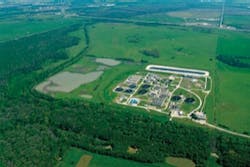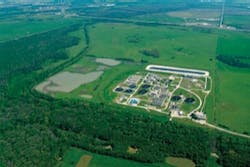Disinfecting drinking water with solar UV
By Emil Venere
The system uses the sun's ultraviolet radiation to inactivate waterborne pathogens. Sunlight is captured by a parabolic reflector and focused onto a UV-transparent pipe though which water flows continuously.
"We've been working on UV disinfection for about 20 years," said Ernest "Chip" R. Blatchley III, a professor of civil engineering. "All of our work up until a couple years ago dealt with UV systems based on an artificial UV source. What we are working on more recently is using ultraviolet radiation from the sun."
Motivating the research is the need to develop practical, inexpensive water-treatment technologies for a large segment of the world's population in developing nations.
"More than 800 million people lack access to what we consider to be 'improved' water," Blatchley said. "The water available for people to drink in many developing countries hasn't been treated to remove contaminants, including pathogenic microorganisms. As a result, thousands of children die daily from diarrhea and its consequences, including dehydration. Half of the world's hospital beds are occupied by people who are sickened by the water they drink."
Blatchley built the parabolic reflector in his garage. The team, including an undergraduate student supported by a National Science Foundation program, finished the prototype in the lab, lining it with aluminum foil. The system was then tested on the roof of Purdue's Civil Engineering Building.
"It turns out that the solar radiation we receive in Indiana at some times of year is intense enough to inactivate some waterborne microorganisms with this type of system," he said. "We demonstrated that we can disinfect water using sunlight. The reactor was very inexpensive to build, less than $100 for the materials."
The natural UV system inactivated E. coli bacteria. However, the system must be able to kill dangerous pathogens such as Vibrio cholerae, which causes cholera, and Salmonella typhi, which causes typhoid, and Cryptosporidium parvum, which causes cryptosporidiosis, a parasitic disease that causes diarrhea.
"In the future we want to prove that our solar-UV system is going work against these other pathogens," said Blatchley, who has worked on the project with doctoral student Eric Gentil Mbonimpa, who is from Rwanda, and Bryan Vadheim, an undergraduate from Montana State University. "We also want to automate it and build sensors for it so that we know how fast the water should be pumped through the system, depending on how sunny it is at any particular time."
The NSF funded Vadheim's work through its Research Experiences for Undergraduates program.
The parabolic reflector is made out of a wood called paulownia.
"That material was selected because the tree grows very rapidly in regions near the equator, where many people lack safe drinking water," Blatchley said. "It is very light, strong and stable, so it's not going to twist or warp or bend or crack in a climate that's alternating between humid and dry."
Natural UV has a longer wavelength than most artificial UV sources, which means it has less energy. Blatchley's hypothesis, however, is that UV from sunlight will inactivate pathogens via the same mechanism as artificial UV: The radiation damages the genetic material of microbes, preventing them from reproducing.
"We are looking at other inexpensive reflecting materials, for example metalized plastic," Blatchley said. "It's similar to the material that's used to make potato chip bags. We've done measurements, and some of these materials are about twice as reflective as aluminum foil."
Improving water quality in developing countries is one of 14 "grand challenges" established by the National Academy of Engineering and also has been named a "millennium development goal" by the United Nations.
Blatchley also is working on an inexpensive filtration system that uses layers of sand and gravel to clean water. The filters were developed by Aqua Clara International, a Michigan-based non-profit corporation. Purdue and Aqua Clara are teaming up with Moi University in Kenya on that project. Purdue students tested the behavior of the filters in a Global Design Team project in Africa through Purdue's Global Engineering Program.
Water flows slowly through the filter, allowing a bacterial film to establish near the top of the filter to remove organic contaminants while certain pathogens also are removed by attachment to the sand.
However, the water may still require disinfection to kill remaining pathogens, and it might be possible to use the slow-sand filters in combination with a water-disinfection system like the new solar UV approach.
"We want to develop drinking water treatment systems that improve water quality for people in developing countries, using Kenya as an example," Blatchley said.
Aqua Clara has developed a business model for the filtration system.
"This provides business opportunities for local entrepreneurs who are trained how to make these filters out of locally available materials," he said. "You can build one of these things for $10, and it's capable of producing something like 40 liters of water a day. It's intended to produce enough water for a family of four."
The use of the filters is becoming more widespread.
"About 1,900 of the sand filters have been installed in villages throughout Kenya," said William Anderson, director of the Global Engineering Program. "More and more, Purdue's faculty and students are extending our land-grant tradition for the benefit of people throughout the world."
###

